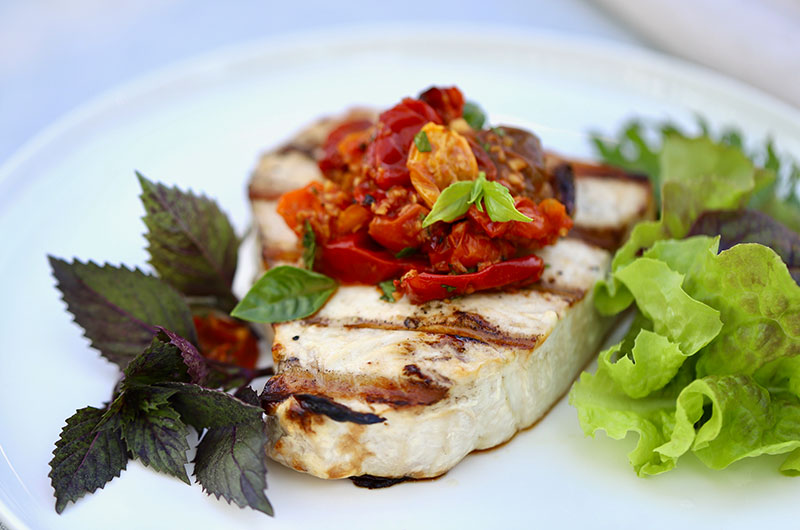I think I’ve finally found my ideal summer entertaining recipe. It’s low-stress, has a make-ahead element, and delivers big flavor with a minimum amount of effort. What’s the secret? Island ingredients. It’s August, after all! When you’ve got the freshest fish and the ripest tomatoes, you need only apply a little heat, harvest a few fresh herbs, and pour a glass of wine to pull off an easy dinner with friends.
Of course, you want a nifty twist or two, and my recipe for Grilled Swordfish with Roasted Tomato-Ginger Compote and Lemon Basil has those.
The mention of fish can sometimes strike fear in the heart of cooks. Sure, fine, eat all the delicious fish you can this summer when someone else is cooking it. But at home? What if it sticks to the pan? Sticks to the grill? Overcooks or undercooks? Fear not, swordfish steaks on the grill couldn’t be easier to pull off. Make sure your grill is good and hot and that you scrape the grates before starting. Season the fish with salt and pepper and brush a bit of mayonnaise on it. This will help to keep the fish moist.
Our Island fish markets usually cut 1¼-inch-thick swordfish steaks. This is thicker than you’ll see in other places, but it means you can get nice grill marks (and flavor) on both sides of the fish and still have a moist interior. This is also one instance where you can use timing as a “doneness” test – especially if you practice on your grill by cooking swordfish for your own dinner before you have guests over. I like to cook mine about six to seven minutes on the first side and five to six minutes on the second side. But if you like your fish slightly less done, you could experiment with taking it off a minute or two sooner. (Don’t fuss with the fish or move it around when it is cooking on the first side – you don’t need crosshatch marks!)
One thing you can count on: delicious flavor and texture. The swordfish we get in Vineyard seafood stores in mid- and late summer is sweet and briny with tender, rich flesh. Mike Holtham of The Net Result in Vineyard Haven says, “The best swordfish you can eat comes from the cold North Atlantic waters from late June to August.”

By North Atlantic, he’s referring to anywhere from Georges Bank to the Grand Banks. Swordfish migrate long distances, moving from warm to colder waters during the year in pursuit of food. The swordfish in fish markets here in the winter is from warmer waters; the cold-water fish we get in the summer is likely tastier due to an increase in omega-3 fatty acids and water with fewer impurities.
While historically swordfishing – in particular, harpoon swordfishing – made a good livelihood for Island fishermen, today our Menemsha fishing fleet does not include a boat with a swordfish license. Holtham, like other Island fishmongers, has a network in Boston that gets him the freshest swordfish. Most of the fish is caught on longlines these days, and longline fishing has progressed in this country to be more environmentally friendly, with efforts to minimize by-catch of seabirds and other fish species.
But Holtham still gets some harpooned swordfish. “I’ve put the word out that I’ll buy the whole catch if harpooned swordfish comes in,” he says. If he’s got it, he’ll advertise it. Subscribing to The Net Result’s “Today’s Special” newsletter is one way to keep in the loop on that.
I’m not a big fan of marinating fish – I prefer to put the flavor on after cooking with some kind of sauce. Even a simple lemon and herb vinaigrette, with perhaps some chopped olives or capers, can do the trick. But since tomatoes are such a natural with swordfish, I put my favorite Vineyard summer ingredient to good use for this recipe. I roast cherry or grape tomatoes until they are soft and caramelized and mix them with a generous amount of chopped fresh ginger, a little balsamic, and a little orange juice. The result is a jammy compote that, frankly, is delicious on anything but particularly on swordfish.

The compote also gives me a chance to try out the different kinds of basil I’m growing this year. I’ve got two kinds of Thai basil, as well as Mrs. Burns’ lemon basil and a serrated opal basil, in addition to sweet basil. I grow these different varieties not only for their bold flavors, which range from licorice-y to citrusy to peppery, but because they tend to be more disease resistant than the sweet basil. I think the lemon basil is particularly nice with the tomato-ginger combo. But you could also use another tender herb, such as mint or cilantro, if you like. The swordfish can stand up to it.
And you can stand to relax! The compote is made, and the fish is ready to go on the grill. You’ve got a green salad mixed. An outdoor table is set, and the drinks are on ice. Don’t forget to slice up some airy artisan bread, such as ciabatta, brush it with oil, and toss that on the grill after you cook the fish. The whole evening will be delicious and beautiful – provided the weather cooperates.








